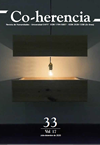Cinematographic Interpretations of Cinco metros de poemas: An Intermedia Approach on the Work of Carlos Oquendo de Amat
Main Article Content
Keywords
Oquendo de Amat, poetry, movies, intermedia, Latin American literature, edition
Abstract
Humanistic research acquires a new nuance in the analyses that involve languages from different artistic disciplines. Therefore, in this article, an intermedia analytical approach to the work Cinco metros de poemas by Carlos Oquendo de Amat is aimed at, starting from the movie strategies found in his poems, extracted from the semiology of the cinematographic discourse. This analytical point sheds light on the complex virtuosity of his work, applying the theories of camera movement and production in his poems. Thus, it is observed how the author achieves a combination of the Aesthetics of Jean Epstein and the techniques of an abstract movie, with deep hermeneutics about the evolution of time. With artistry similar to the harmonic production in the work of Eisenstein, this work is successful in involving the “spectator” intellectually and emotionally thanks to the complex staging of its five meters of poems.
Downloads
References
Aumont, J. (2004). Las teorías de los cineastas. Paidós.
Belli, C. G. (2013). Imágenes impresas: “El libro como objeto estético”. 5metrosdepoemas.com. https://bit.ly/2ZQLbpE
Bubnova, Tatiana. (2006). Voz, sentido y diálogo en Bajtín. Acta poética, 27(1), 97-114. https://bit.ly/30AH1Bp.
Carmona, R. (1991). Cómo se comenta un texto fílmico. Cátedra.
Casetti, F. y Di Chio, F. (1991). Cómo analizar un film. Planeta.
Chatman, S. (1990). Historia y discurso: la estructura narrativa en la novela y en el cine. Taurus.
Cillóniz, A. (Ed.). (1989). Poesía hispanoamericana. Alborada.
De los Ríos, V. (2007). Literatura y tecnología en Darío, Oquendo de Amat y Palma. Romance Notes, 48(1), 91-99. https://doi.org/10.1353/rmc.2007.0003
Eisenstein, S. (1926). Film Form Essays in Film Theory. Hartcourt.
Eisenstein, S. (1972 [1933]). Cinematismo. Domingo Cortizo Editor.
Elleström, L. (Ed.). (2010). Media borders, multimodality and intermediality. Springer.
Englund, A. (2010). Intermedial Topography and Metaphorical Interaction. En: L. Elleström (Ed.), Media borders, multimodality and intermediality (pp. 69-80). Springer.
Epstein, J. (1920). La poesía de hoy. Un nuevo estado de inteligencia. J. Samet.
Frank, J. (1991). Spatial form in modern literature, the idea of spatial form. Rutgers University.
Gómez de Tejada, J. (2017). Carlos Oquendo de Amat: el poema acéntrico como espacio lírico alternativo a la metrópolis moderna. Tonos Digital, (32), 1-23. http://hdl.handle.net/10201/51903
Gómez, N. (2008). La sombra de Charles Chaplin en César Vallejo. Espéculo: Revista de Estudios Literarios, 39. https://bit.ly/2E80hid
Hernández Les, J. A. (2005). Cine y literatura: Una metáfora visual. Ediciones JC Clementine.
Higgins, D. (1967). Statement of intermedia. En W. Vostell (Ed.), Dé-coll/age (décollage) 6. Typos Verlag. https://www.artpool.hu/Fluxus/Higgins/intermedia2.html
Ibáñez, A. (2017). Letras de celuloide: una lectura de 5 metros de poemas de Carlos Oquendo de Amat. 452ºF, (17), 173-190. https://bit.ly/3hgQRPI
Illouz, E. (2009). El consumo de la utopía romántica. Katz.
Kristeva, J. (1968). Poésie et negativité. L’Homme, 8(2), 36-63. https://doi.org/10.3406/hom.1968.366977
Lauer, M. (2004). Musa mecánica. Máquinas y poesía en la vanguardia peruana. Instituto de Estudios Peruanos.
Meneses, C. (1973). Tránsito de Oquendo de Amat 1905-1936. Inventarios Provisionales
Mitry, J. (1990). La semiología en tela de juicio (cine y lenguaje). Akal.
Monguió, L. (1954). La poesía postmodernista peruana. University of California Press.
Monguió, L. (2004). Un vanguardista peruano. En O. Aramayo y R. Milla (Eds.), Carlos Oquendo de Amat. Cien años de poesía viva. 1905-2005 (pp. 78-87). Fondo de Editorial Peruana.
Núñez Pacheco, R. (2006). Cinema poesía: un visionario llamado Carlos Oquendo de Amat. En A. Volantines (Coord.), Segundo Congreso de Poesía de la Región de Coquimbo y el Mundo Andino. https://bit.ly/30x5Jmo
Oquendo de Amat, C. (1985). Cinco metros de poemas. Orígenes.
Oviedo Pérez de Tudela, R. (2006). La imagen en Carlos Oquendo. Ómnibus: Revista Intercultural del Mundo Hispanohablante, 2(8), http://www.omni-bus.com/n8/oquendo.html
Peña Ardid, C. (1992). Literatura y cine: una aproximación comparativa. Cátedra.
Pessis García, B. (2014). El cine, los sentidos y el mercado en 5 metros de poemas de Carlos Oquendo de Amat. Dialogía, (8), 4-21. https://bit.ly/2ZO3745
Sales Delgado, C. M. (2010). Ciudad y vanguardismo en “New York” de Carlos Oquendo de Amat. LL Journal, 5, 1. https://bit.ly/3hpvlbo
Sánchez Rodríguez, A. (1992). La inmolación perpetua de Carlos Oquendo de Amat. Scriptura, (8-9), 255-265. https://bit.ly/2WJceS2
Sánchez-Biosca, V. (2009). El montaje: entre cine, literatura y plástica. En C. Peña Ardid (Coord.), Encuentros sobre literatura y cine (pp. 93-108). Instituto de Estudios Turolenses. https://bit.ly/2CsRnvl
Siles Ojeda, B. (2000). Una mirada retrospectiva. Treinta años de intersección entre el feminismo y el cine. Caleidoscopio. Revista del AudioVisual, 1(1). https://bit.ly/3eKq10E
Tynjanov, Y. (1971 [1927]). Fundamentos del cine. En Miguel Bilbatúa (Ed.), Cine soviético: Teoría y lenguaje (pp. 113-143). Alberto Corazón.
Urrutia Gómez, J. (2000). Cine y poesía. Príncipe de Viana. Anejo, (18), 405-414. https://bit.ly/2WDMQgn
Valero Juan, E. (2008). Geografías de poesía y vida en los “Cinco metros” de Carlos Oquendo de Amat. Anales de Literatura Española, (20), 303-317. https://bit.ly/39gurv4
Vargas Llosa, M. (1983). La literatura es fuego. En Contra viento y marea (1962-1982) (pp. 132-137). Seix Barral.
Villaplana Ruiz, V. y Ortuño Mengual, P. (2018). Film Poetry. Repensando el cine de vanguardia: arte en movimiento y poéticas visuales. Revista de Comunicación de la SEECI, (47), 01-15. http://doi.org/10.15198/seeci.2018.47.01-15




